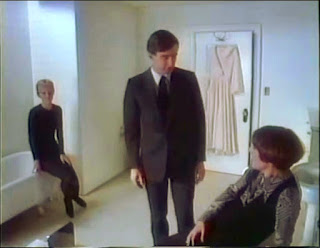John Badham directed this remake of the classic French thriller LES DIABOLIQUES (1955) for the ABC Television Network. It was one of those dark, sordid Movie of the Week presentations that were beamed regularly via cathode ray tubes into the living rooms of the American population. One can probably connect these depressing little photoplays to the growing instability of family life and the gradual decline of Western Civilization. But hey, we all needed something to do, right? And many of these TV flicks were quite well done. REFLECTIONS OF MURDER was one of the best. Its top-billed star is one of my favorite actresses, Tuesday Weld. She is joined by the equally talented Joan Hackett and Sam Waterston.
Hackett plays Claire Elliot, the owner of a large island estate off the coast of Seattle. She and her husband, Michael (Waterston) operate a private boy's school. Michael is a cruel, abusive husband. He hates living on the island and wants Claire to sell the property to a real estate developer so the couple can divorce and split the money. Claire refuses, as she grew up on the property and has a strong attachment to it. She also loves running the school. Michael has been openly having an affair with Vicky (Weld), another teacher at the school. As Vicky begins to experience abuse at Michael's hands, the two women form a bond. Vicky conceives a plan for them to murder Michael and make it look like an accident.
.JPG) |
| Screen goddess Tuesday Weld, up to no good. |
There is plenty of tension, sexual and otherwise, between these three characters. And the execution of the murder plot gets quite physical and surprisingly graphic for a prime-time TV show. Miss Weld, one of the most celebrated sex kittens of the 1960's, is deglamorized considerably. Her hair is cut short, she is reed thin, and her clothing is understated and plain. Still, her beauty and sensuality shine through. Weld gives one of the most controlled and disciplined performances of her career. She is a perfect contrast to Hackett's character. Claire's emotional turmoil keeps increasing, leading to a complete psychic break. Hackett is excellent in her very difficult role. As for Waterston, he plays Michael as a completely one-dimensional character, a stereotypical toxic, abusive male. Fortunately, that one dimension is all that's required, and the actor plays it quite well.
 |
| A not-so-happy threesome. Tuesday Weld, Sam Waterston, and Joan Hackett |
 |
| Vicky (Tuesday Weld) and Claire (Joan Hackett) find that murder is more complicated than they thought. |
While Michael's anger and aggressiveness bring a lot of excitement to the film, the relationship between the two women is the centerpiece of the story. In some scenes, Vicky appears to have an attraction to Claire, one that is not reciprocated. Weld plays these moments with subtlety, and there isn't any sort of suggestive dialogue, which wouldn't have gone over well on 1970's network television. But these moments add another layer of tension and complication to the story. Vicky and Claire make an engaging team until their plans began to fall apart and Claire pushes Vicky away.
Also featured are Lucille Benson, R.G. Armstrong, Michael Lerner, and Lance Kerwin.
John Badham has a long list of credits in film and television, including SATURDAY NIGHT FEVER (1977), WHO'S LIFE IS IT ANYWAY? (1981), and WAR GAMES (1983). Miss Weld would find more success on television. She played Zelda Fitzgerald in F. SCOTT FITZGERALD IN HOLLYWOOD (1976), did a remake of MADAME X (1981), and received an Emmy nomination for THE WINTER OF OUR DISCONTENT (1983), among several others.
This movie has not yet been given a commercial DVD or Blu-ray release, which is the case for many made-for-TV movies. I got my copy from an online seller who records directly from television or VHS tapes. The visual quality isn't anything like a remastered product but is still quite watchable. It also might be available on Youtube. Try to see this one if you can. It's worth the effort!




.jpg)
.jpg)
.jpg)
.jpg)
.jpg)








.jpg)

.jpg)

.jpg)

.jpg)











.jpg)
.jpg)
.jpg)
.jpg)
.jpg)
.jpg)
.jpg)
.jpg)
.jpg)
.jpg)
.jpg)
.jpg)
.jpg)
.jpg)
.jpg)
.jpg)
.jpg)
.jpg)
.jpg)
.jpg)
.jpg)
.jpg)
.jpg)